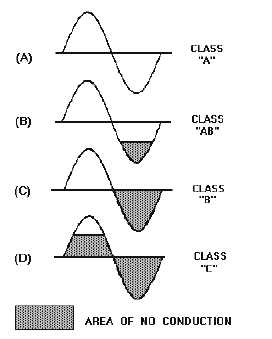2-21
AMPLIFIER CLASSES OF OPERATION
In the previous discussions, we assumed that for every portion of the input signal there was an output
from the amplifier. This is not always the case with amplifiers. It may be desirable to have the transistor
conducting for only a portion of the input signal. The portion of the input for which there is an output
determines the class of operation of the amplifier. There are four classes of amplifier operations. They are
class A, class AB, class B, and class C.
Class A Amplifier Operation
Class A amplifiers are biased so that variations in input signal polarities occur within the limits of
CUTOFF and SATURATION. In a PNP transistor, for example, if the base becomes positive with respect to
the emitter, holes will be repelled at the PN junction and no current can flow in the collector circuit. This
condition is known as cutoff. Saturation occurs when the base becomes so negative with respect to the
emitter that changes in the signal are not reflected in collector-current flow.
Biasing an amplifier in this manner places the dc operating point between cutoff and saturation and
allows collector current to flow during the complete cycle (360 degrees) of the input signal, thus providing
an output which is a replica of the input. Figure 2-12 is an example of a class A amplifier. Although the
output from this amplifier is 180 degrees out of phase with the input, the output current still flows for the
complete duration of the input.
The class A operated amplifier is used as an audio- and radio-frequency amplifier in radio, radar, and
sound systems, just to mention a few examples.
For a comparison of output signals for the different amplifier classes of operation, refer to figure 2-15
during the following discussion.
Figure 2-15.—A comparison of output signals for the different amplifier classes of operation.

